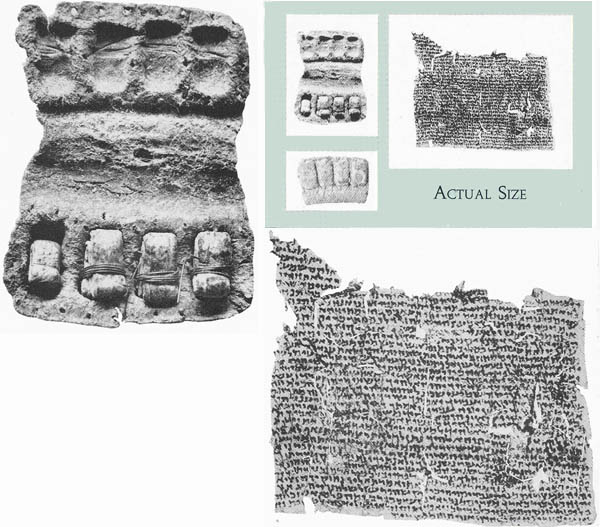Image Details

Israel Exploration Society
Two millennia of tradition link this tefillin (above; for actual size, see upper left photo in green box), dated to the first half of the first century C.E., with modern examples worn by observant Jews for morning services (except on Sabbaths and scriptural holy days). The famous archaeologist Yigael Yadin acquired this tefillin from a Jerusalem antiquities dealer, who said he thought it had been found at Qumran. The capsule, as the packet is called, consists of a piece of leather with four depressions, or compartments, which is folded in half and stitched together. A tubular space is left along the fold so that a strap can be passed through in order to attach the tefillin to the arm or head (in this case, the head). The closed capsule measures half an inch by three quarters of an inch (lower left photo in green box). A folded parchment slip tied with string lies within each of the compartments, seen at bottom in the photo above, left; the parchment at the far left in this photo is foreign to the capsule and was apparently inserted by the finders or by the dealer in order to enhance the tefillin’s value.
When unfolded, the slips in this capsule measure about 1 inch by 1.75 inches. They bear writing in black ink, in square-Hebrew script that is dated to the first half of the first century C.E. The slip in the third compartment from the right was unrolled (right photo in green box and enlarged version below the box). It bears the following biblical passages: Deuteronomy 5:1–21 (the Decalogue) and Exodus 13:11–16 (the consecration of the first-born). This practice of wearing certain selections from the scriptures derives from Deuteronomy 6:8 (“Bind them as a sign on your hand and let them serve as a symbol on your forehead”) and parallel passages in Deuteronomy 11:18 and in Exodus 13:9 and 13:16. These four passages appear on the four slips, one passage for each slip.
